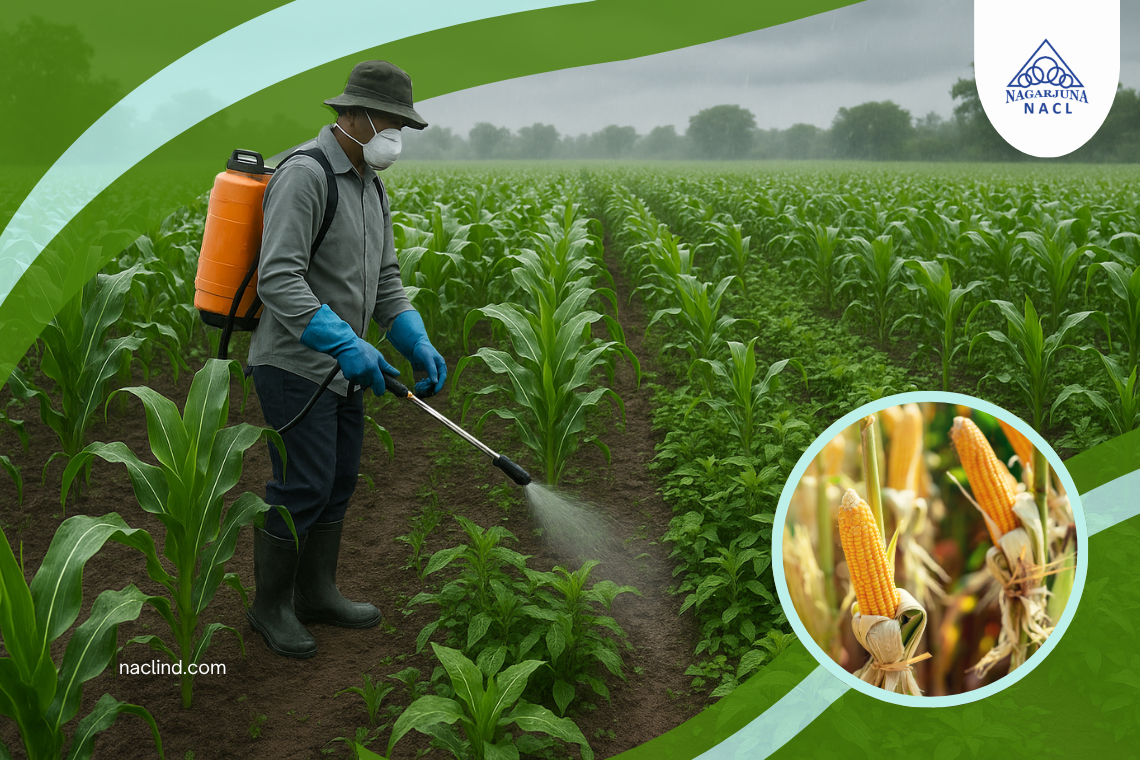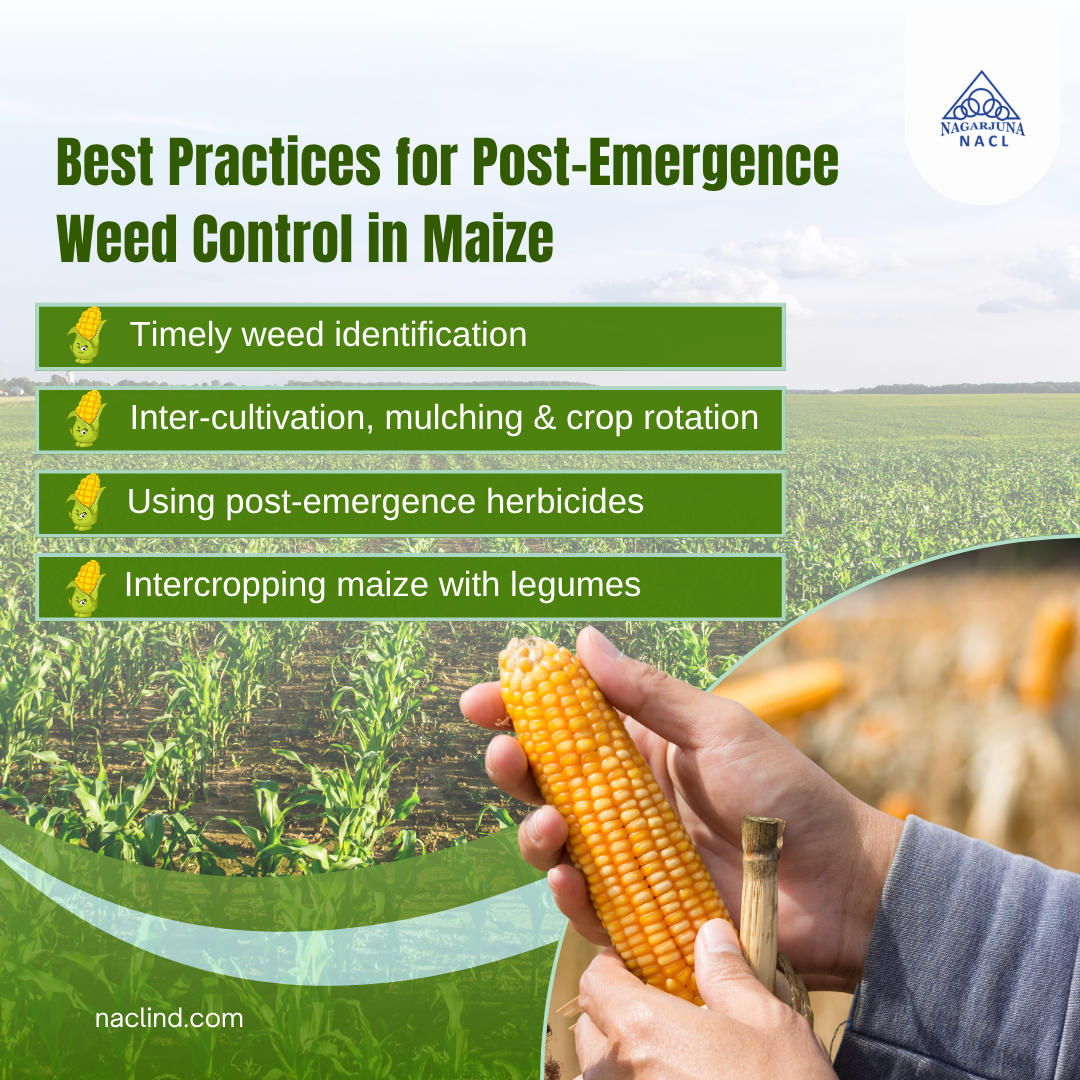
Post-Emergence Weed Control in Maize During the Rainy Season
Maize, or ”Makka” as we commonly call it, is one of the most important cereal crops grown by Indian farmers, especially during the Kharif/rainy season. With increasing demand for both food and fodder, maize has become a highly profitable crop across major states, including Karnataka, Telangana, Andhra Pradesh, Madhya Pradesh, and Bihar. However, one of the biggest challenges farmers face during the monsoon is weed management after crop emergence. Weeds compete with maize for nutrients, water, sunlight, and space, resulting in significant yield losses if not managed promptly.
During the rainy season, when the soil moisture content is high and climatic conditions favour fast germination, weeds grow aggressively. Common weeds such as Echinochloa colona (Sawan grass), Cyperus rotundus (Motha), and Amaranthus species spread rapidly in maize fields. Post-emergence weed control in maize during the rainy season is one of the most critical crop protection practices Indian farmers must follow. Without timely weed management, maize yield losses can be high, making integrated solutions essential.
Farmers today can choose between mechanical methods, cultural practices, and crop protection solutions, depending on their field conditions and labour availability. Thanks to modern agrochemicals, weed control has become more efficient and farmer friendly.
Companies like NACL Industries are providing reliable crop protection solutions tailored to Indian conditions, helping farmers maximize maize productivity even during the peak rainy season.
In this blog, let’s discuss why post-emergence weed control is important in maize, the best available practices for Indian farmers, and how to balance traditional methods with modern solutions for better yield and profitability.
Key Takeaways
- Farmers can adopt mechanical, chemical, or integrated weed control practices.
- Post-emergence weed management is critical in the first 30–40 days after sowing.
- Timely herbicide application with correct dosage ensures maximum effectiveness.
- Integrated methods enhance yield, improve soil health, and promote sustainability.
Why Post-Emergence Weed Control is Crucial in Maize
Maize is a wide-row crop, which means there is enough open space between plants in the early stages. This open space, combined with abundant rainfall, provides a conducive environment for weeds to germinate and flourish. Weeds like Doob grass (Cynodon dactylon) and Sawan grass grow faster than maize seedlings and therefore suppress their growth.
- Critical Period of Weed-Crop Competition: In maize, the first 30–40 days after sowing are crucial. If weeds are not controlled during this period, significant yield losses can occur.
- Rainy Season Weed Pressure: During the monsoon, weeds like Echinochloa (barnyard grass), Cyperus (nut sedge), Amaranthus, and Digitaria proliferate rapidly. These weeds thrive in moist soils and quickly overtake young maize plants.
- Labour Challenges: Manual weeding is effective but difficult during rainy days, and moreover, the labour costs are increasing.
- Nutrient Drain: Weeds rob maize of nitrogen and other major nutrients, leaving plants pale and stunted.
Best Practices for Post-Emergence Weed Control in Maize
1. Timely Weed Identification
Farmers should regularly inspect their maize fields after sowing. Identifying the type of weeds (grassy vs. broadleaf) helps in selecting the right herbicide or control method.
2. Cultural and Mechanical Practices
- Inter-cultivation: Using local weeders or hoes 20–25 days after sowing helps loosen the soil and uproot weeds. Two timely manual weeding (at 20 and 40 DAS—days after sowing) can significantly reduce the weed pressure.
- Mulching: Applying crop residues or plastic mulch not only reduces weed germination but also conserves soil moisture.
- Crop Rotation: Alternating maize with pulses or legumes reduces weed seed build-up and adds fertility.

3. Use of Post-Emergence Herbicides
Chemical weed control is highly effective during the monsoon when weeds germinate continuously. Post-emergence herbicides are sprayed on actively growing weeds to control them.
Commonly Used Herbicides:
- Tembo-/Atrazine + Safeners (used carefully depending on soil moisture)
- Topramezone-based formulations – control major grasses and broadleaf weeds.
- Nicosulfuron or Halosulfuron mixes – effective on grasses as well as Cyperus.
Note: Always read the label and consult a local agricultural officer before using herbicides.
Do’s for Post-Emergence Herbicide Use:
- Spray when maize plants are at the 3–6 leaf stage (15–25 days after sowing)
- Follow label recommendations and correct dosage.
- Use flat fan nozzles for uniform spraying.
- Mix with adjuvants for better sticking and spreading on leaves.
Don’ts:
- Avoid spraying just before rainfall.
- Do not overdose, as it may harm the maize crop.
- Never mix incompatible herbicides without proper advice.
4. Integrating Traditional Indian Practices
For optimal results, farmers should adopt a combination of methods rather than relying solely on one approach. Indian farmers have traditionally used practices like intercropping maize with legumes (pigeon pea, cowpea) to suppress weed growth naturally. For example:
- First weeding manually at 20 DAS (days after sowing), followed by targeted herbicide spray.
- Using agrochemical crop protection solutions for tough perennial weeds.
- Mulching with previous season residues to minimize fresh weed growth.
This approach reduces cost, saves labour, prevents herbicide resistance, and ensures higher maize yield.
Special Considerations During the Indian Rainy Season
- Soil Type Matters: On black cotton soils, weeds like nut sedge dominate. On sandy loam soils, grasses proliferate faster.
- Timing is Everything: A delay of even one week in herbicide application during the monsoon can allow weeds to overtake maize.
- Farmer Safety: Farmers should wear protective clothing, use gloves, and refrain from barefoot spraying to ensure their safety while handling agrochemicals.
- Sprayer care: Ensure nozzles are clean and produce fine to medium droplets for better coverage.
- Clean the spray tank & nozzle before and after herbicide application to avoid cross contamination.
Conclusion: Protecting Maize for Higher Yields
Maize holds immense promise for Indian farmers, especially during the rainy season, but weeds continue to be a significant barrier to productivity. Timely and effective post-emergence weed control in Maize—through a combination of cultural practices and selective crop protection solutions—can significantly improve farmer profitability.
Leading agri-input providers, such as NACL Industries, are equipping farmers with modern agrochemicals and innovative crop protection solutions that ensure sustainable farming while safeguarding the health of crops and soil.
By embracing integrated weed management, Indian farmers can effectively combat weeds, minimize labour-intensive tasks, and maximize the full potential of their maize crops, even during the challenging monsoon months.

